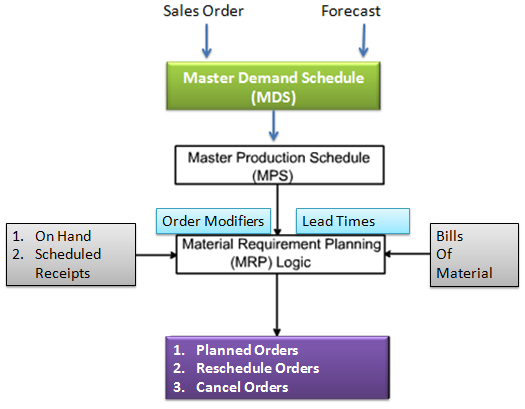MRP Process Flow

The three major inputs of an MRP system are the master production schedule, the product structure records, and the inventory status records. Without these basic inputs the MRP system cannot function.
The demand for end items is scheduled over a number of time periods and recorded on a master production schedule (MPS). The master production schedule expresses how much of each item is wanted and when it is wanted. The MPS is developed from forecasts and firm customer orders for end items, safety stock requirements, and internal orders. MRP takes the master schedule for end items and translates it into individual time-phased component requirements.
The product structure records, also known as bill of material records (BOM), contain information on every item or assembly required to produce end items. Information on each item, such as part number, description, quantity per assembly, next higher assembly, lead times, and
quantity per end item, must be available.
The inventory status records contain the status of all items in inventory, including on hand inventory and scheduled receipts. These records must be kept up to date, with each receipt, disbursement, or withdrawal documented to maintain record integrity.
MRP will determine from the master production schedule and the product structure records the gross component requirements; the gross component requirements will be reduced by the available inventory as indicated in the inventory status records.
Information Needed for MRP
- Demand for all products.
- Lead times for all finished goods, components, parts and raw materials
- Lot sizing policies for all parts
- Opening inventory levels
- Safety stock requirements
- Any orders previously placed but which haven't arrived yet
Information Obtained from MRP
- Planned orders: replenishment orders to be released at a future time
- Order release notice: notices to release planned orders
- Action notices: notices to expedite, de-expedite, or cancel orders, or to change order quantities or due dates
- Priority reports: information regarding which orders should be given priority
- Inventory status information
- Performance reports such as inactive items, actual lead times, late orders, etc.